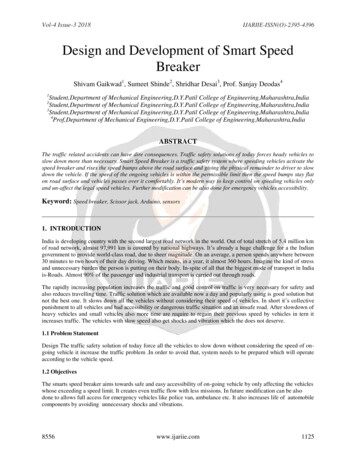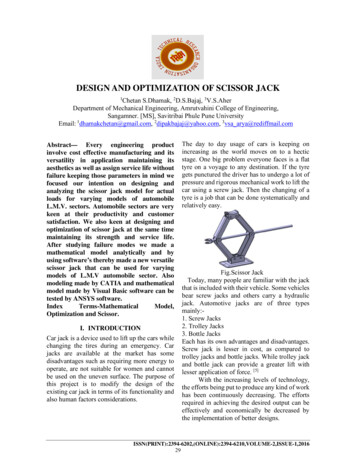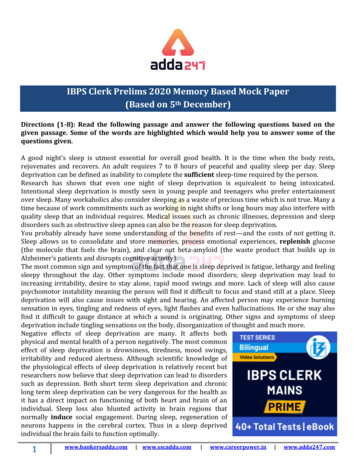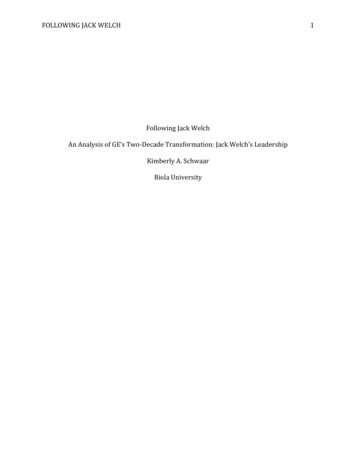
Transcription
Summer 2014 NewsletterEdited byPongpunya Jack Korpob & Laurel Dreher
Letter from the Newsletter EditorHello!The summer has been a whirlwind. I recently earned my Masters degree and have started my firstprofessional position as a Residence Director at the University of Vermont.After a couple weeks of winding down previous positions and packing everything, I made themove. As training picks up in my position, I often think about how I will support male students inthe residence halls and how my male identity affects the work I do.I’m very lucky that the department I am working in values social justice and work around diversityand inclusion work. While doing the professional work, and I hope to continue doing the personalwork and exploration around my own male identity and what masculinity means, especiallybecause this work is supported by colleagues.I really enjoyed all the articles submitted for this issue of the MMKC newsletter and hope youenjoy them, too! I hope everyone is enjoying summer, and good luck to those already preparingfor the next academic year!-Jack KorpobMen & Masculinities Knowledge CommunityLeadership Team (as of 4/14/14)Patrick Tanner,ChairJames A. Lorello,Chair ElectAaron W. Voyles,Chair ElectDirector of Student andEnrollment ServicesUniversity Housing CoordinatorAppalachian State Universitylorelloja@appstate.eduThe University of Texasat Austinaaron.voyles@austin.utexas.eduSan Francisco State Universityodelvall@sfsu.eduPongpunya Jack Korpob,Newsletter EditorBarry A. Olson,Scholar-Practitionerin-ResidenceTerrell Lamont Strayhorn,Faculty-in-ResidenceThomas Fritz,Awards ChairPennsylvania StateUniversity-Yorkptanner@psu.eduResidence DirectorJester Area ManagerOsvaldo Del Valle,Immediate Past ChairAssociate ProfessorDirector of Student ConductDirector, NorthEngagement CenterDirector of BusinessAdministrationOhio StateUniversity-Main CampusStrayhorn.3@osu.eduRick Lofgren,Drive-In CoordinatorLogan Denney,Mentorship CoordinatorLaurel Dreher,Special Projects CoordinatorMiami Universitylofgrer@miamioh.eduOregon State Universityloganrdenney@gmail.comChristina F. Kaviani,Special Projects CoordinatorCoordinator, Safer & GenderEquity CenterCalifornia Polytechnic StateUniversity– San Luis Obispockaviani@calpoly.eduMatt Zalman,Social Media CoordinatorMichael Ormsby,Region I RepresentativeJude Butch,Region II RepresentativeHawken Brackett,Region III RepresentativeUniversity of Hartfordormsby@hartford.eduUniversity at Buffalojude.butch@gmail.comClemson Universityhawkensb@clemson.eduOlaf Standley IV,Region IV-W RepresentativeJohn R. Paul,Region V RepresentativeKoby Rodriguez,Region VI RepresentativeNortheastern State Universitystandleo@nsuok.eduCornish College of the Artsjpaul@cornish.eduUniversity of Vermontpkorpob@gmail.comNorth Carolina StateUniversity at Raleighbaolson@ncsu.eduAssistant Director of Residence LifeCoordinator for Academic Initiativesand Residential LearningCommunitiesAppalachian Statezalmanma@appstate.eduBrian Anderson,Region IV-E RepresentativeInterfaith Campus MinisterLoyola University Chicagobanderson2@luc.eduPage 2Resident DirectorAssistant Director,Student RetentionCoordinator ofAcademic ConsultationLeadership ProgrammingCoordinatorDirector of Housing andResidential LifeMichigan State Universityfritzjrt@rhs.msu.eduAssistant Director for StudentLeadership and ProgramsBerklee College of Musicldreher@berklee.eduAssistant Director ofCareer DevelopmentCross Cultural CenterAssistant Director of CampusDiversity & InclusionUniversity of Redlandskorodriguez@ucdavis.eduMen & Masculinities Knowledge Community Summer 2014 Newsletter
Table of ContentsLetter from the Newsletter Editor.2By Jack KorpobLetter from the Chair . . .4By Patrick TannerSeven Educational Research Centers Respond to White House Report on Boys and Young Men of Color .5By Shaun R. Harper, Frank Harris III, J. Luke Wood, Bryant T. Marks, Victor B. Saenz, Luis Ponjuan, James L.Moore, Tyrone C. Howard, and Jerlando F.L. JacksonImproving Institutions: MOCI’s Importance of Male Students of Color Empowerment .6By Pablo John & Jaime Miguel McCarthy with support from Christopher RamirezBe the Best Dad Campaign .7By Ron J. ClarkAbout Manhood: Exploring Values in College 8By Terrance D. SmithOops, It’s a Boy: Gender Identity and the Genetics of Masculinity .10By Nicholas BarnesMake Total Destroy: My #SACommits Confessional .12By Craig BididmanArticle Submission Guidelines.16Connect with us on Social Mediahttps://www.facebook.com/home.php?sk group 113124018828Visit Us on the NASPAWebsite & Read Our Blog:https://twitter.com/NASPA n-and-masculinitiesMen & Masculinities Knowledge Community Summer 2014 NewsletterPage 3
Letter from the ChairSometimes I read.I go to meetings, Irespond to email, Istrategize, I coordinate, Ipresent, I write, and Imediate, but rarely do Iread. Not because Idon’t want to, and notbecause I don’t havetime. I’m convinced thatI can do anything I wantas long as I make it apriority. I learn thislesson daily as I witnesssuccessful students,researchers, andentrepreneurs. I don’t read because I don’t want to. It istough to admit that, but it’s true.desires, and how she never tires of seeking new challenges.Then I got hungry. Everything old looked new. Problemslooked like opportunities. Frustrations became challenges.Fears became aspirations.As we turn the corner on this brief respite we call summerand stare down another academic year, what are you goingto change? Are you finally going to start talking with somestudents about creating that men’s discussion group? Areyou going to decide to read one article on masculinity eachweek? Are you going to mentor someone on your campusor are you going to ask a senior colleague to be yourmentor? Are you going to write for the MMKC blog? Wouldyou consider stepping out and joining the MMKCMentorship Initiative? Will you nominate a colleague for awell-deserved award? You’ve still got a few weeks to submita proposal to present at the annual conference in NewOrleans. You’ve still got time to submit a proposal to yoursupervisor to ask for start-up funding for a pilot initiative tofacilitate programming around gender topics.The silver lining though, is that we humans can change, andchange happens one decision at a time.Please enjoy the content of this newsletter, and know thatwe are the sum of our decisions - thousands of dailyThe other day I decided I wanted to read again. I just had a decisions. I’m so glad that I decided to read again. Whatfriend decide to write again. I had another friend decide to will you decide to do today?take charge of her health for the first time in years. Anotherfriend decided to get out of a bad relationship. AnotherBe well and at peace,friend decided to pursue a dream. Witnessing change ispalpable, it’s powerful!Patrick TannerMMKC ChairThose few minutes I spent reading were inspirational, as acolleague had written about her passions, her professionalPage 4Men & Masculinities Knowledge Community Summer 2014 Newsletter
Seven Educational Research Centers Respond to White HouseReport on Boys and Young Men of ColorBy Shaun R. Harper, Frank Harris III, J. Luke Wood, Bryant T. Marks, Victor B.Sáenz, Luis Ponjuan, James L. Moore III, Tyrone C. Howard, andJerlando F. L. JacksonIn response to a recent task force report to PresidentBarack Obama on My Brother’s Keeper, an initiative thatbrings together private sector and philanthropicorganizations to improve the lives and outcomes of boysand young men of color in the United States, sevenuniversity-based research centers have jointly issued astatement.what works, as well as funding new studies on promisingpolicies and practices, would help ensure the success of MyBrother’s Keeper and the Americans it aims to effectivelyserve.We urge private foundations, federal funding agencies (i.e.,the Institute of Education Sciences, the National ScienceFoundation, and the National Institutes of Health), andThe Center for the Study of Race and Equity in Educationother entities that invest in projects associated with My(University of Pennsylvania), Minority Male CommunityBrother’s Keeper to take seriously the evidence base ofCollege Collaborative (San Diego State University),initiatives that are proposed, as well as rigorous evaluationsMorehouse Research Institute (Morehouse College), Project of newly funded projects. Funds are needed to facilitateMALES and the Texas Education Consortium for Maleproductive collaborations among research centers such asStudents of Color (University of Texas at Austin), Toddours, and to connect researchers with agents who leadAnthony Bell National Resource Center on the Africanorganizations and initiatives for young men of color acrossAmerican Male (The Ohio State University), UCLA Blackour nation. The success of My Brother’s Keeper dependsMale Institute (University of California, Los Angeles), andheavily on the quality of research produced about itsWisconsin’s Equity and Inclusion Laboratory (University ofeffectiveness. Ultimately, strong cultures of evidence andWisconsin-Madison) are all research enterprises thatefficacy should guide all programs, services, andrigorously and routinely study factors that enable and limit interventions associated with the initiative.educational, social, and occupational opportunities for boysand young men of color.My Brother’s Keeper affords our country an importantopportunity to reframe hopeless, deficit-oriented narrativesLeaders of the seven centers emphasize the importance of about boys and young men of color, schools that educateeffective research-based interventions and are jointlythem, and communities in which they live. We are hopefulissuing the following statement in response to the taskthat the initiative will produce replicable models of success,force report:but doing so requires more investment in studies of whatworks. To ensure the success of My Brother’s Keeper, our"As Black and Latino male professors and research centerresearch centers stand ready to serve as resources to itsdirectors, we salute President Obama as well as the manyfunders and the Obama Administration."philanthropic and private sector funders for theircommitment to improving the conditions of our nation’sThe authors of this article can be reached at:boys and young men of color.Shaun R. Harper, University of Pennsylvania,The task force report offers a commendable articulation of sharper1@upenn.edu;Frank Harris III, San Diego State University,challenges and opportunities for young men of color andvarious agents who play some role in their life outcomes.frank.harris@sdsu.edu;J. Luke Wood, San Diego State University,Recommendations offered therein are appropriatelyinformed by research from a range of academic disciplines. jwood@mail.sdsu.edu;Bryant T. Marks, Morehouse College,As our nation prepares to enact recommendations from the Bryant.Marks@morehouse.edu;Victor B. Sáenz, University of Texas at Austin,task force, we call for programs, policies, and services thatare guided by research and documented effectiveness. We vsaenz@austin.utexas.edu;caution, for example, against the widespread replication of Luis Ponjuan, Texas A&M University,mentoring programs that haphazardly match young menluis.ponjuan@tamu.edu;James L. Moore III, The Ohio State University,with adults, as evidence concerning the outcomes of suchprograms is mixed. Moreover, we believe interventionsmoore.1408@osu.edu;Tyrone C. Howard, University of California, Los Angeles,should focus on better understanding and remedyingsystemic inequities in policies, schooling and socialthoward@gseis.ucla.edu;Jerlando F. L. Jackson, University of Wisconsin-Madison,practices, and structures that persistently undermine thesuccess of boys and men of color. More significantjjackson@education.wisc.edu.investment in the dissemination of existing research onMen & Masculinities Knowledge Community Summer 2014 NewsletterPage 5
Improving Institutions: MOCI’s Importance of Male Studentsof Color EmpowermentBy Pablo John & Jaime Miguel McCarthy with support from Christopher Ramirez“Succeeding in college is all about connecting with thepeople around you. Don’t be afraid to use me as a resource.Don’t be afraid to ask for help from everyone, that’s howyou grow.”sees over 25,000 people on a daily basis and knows us onlyby identification numbers. Groups like MOCI have adifferent perspective, with goals of inclusion andengagement.As we table at orientations for incoming University of NewMexico freshmen, we see glazed eyes, deer in theheadlights – students are seemingly dazed by theinformation thrown at them over the course of three daysand don’t know where to begin – and when consideringwhere they’ll end up in four years, that’s the problem.This summer, we are participating as interns with MOCI andStrong Families New Mexico, a project of Forward Together.We are focused on “community building”, or civicengagement, for male students of color. This includesdoing outreach at orientation, planning events, attendingcoalition meetings, facilitating workshops, and otherprojects to promote access and success for male studentsof color in higher education and the K-12 and communitycollege pipeline. We are also being coached and mentoredby the project’s coordinator, Christopher Ramirez, andother campus and community partners.UNM caters to a different demographic of society thanmany public schools. As the flagship institution of amajority-minority state, we are blessed to see an incredibleamount of diversity represented in every lecture hall, dormroom, and student organization. The numbers atCommencement, however, are a different matter.Through the Men of Color Initiative, we have been able tosee first-hand how involvement leads to positive collegiateAccording to graduation rates compiled byexperiences. This summer, we have had the opportunity tocollegeresults.org in 2012, UNM graduates only 45.1% ofdo community gardening in Albuquerque’s South Valley,students – in six years (the “traditional” four-year numberwhich exposed us to ideas of togetherness andhovers around 12%). This number is bad enough, but when sustainability, two concepts that are lacking in manyput in the context of race, gender, and ethnicity, it is farconventional forms of education. We also were able toworse.present at a youth conference, forcing us to think critically,shape ideas, and respond to the always-quick inquiries ofOnly 44.3% of Latino students graduate within six years.the next generation. We are learning as much through theBlack students have struggled as well, with 34.9% of themexperience of facilitating as did the students who weregraduating. Finally, Native American students have a rate of supposed to learn from us. And this is the most importantjust 24.3%. Overall, only 40.9% of men at UNM graduate,piece of information of all: education is best gainedcompared to 48.6% of women, a number that is proven tothrough doing.be most problematic for minorities through further number-crunching. The result? A heightened need for resources for By doing things as men of color with our community, westudents of color, especially men. Hence, the development are growing and learning about ourselves and ourof our organization, the Men of Color Initiative (MOCI) incommunities. We are making new relationships, seeing how2011.we are connected as men of color and use each other asrole models. We are also learning that we are “strongerMOCI is a program under the umbrella of the university’stogether” as male students of color coming from diverseDivision for Equity and Inclusion (DEI) and Office of Student backgrounds; we can share with each other our cultures,Academic Success (OSAS), focused on improving retention experiences, histories, languages and struggles.and graduation rates among men of color, as well as theoverall college experience of all students. All projects areThe concept is simple: involved, goal-oriented studentsgeared at developing leadership skills, academic progress,succeed. At the University of New Mexico, MOCI is thecreative expression, and community engagement.answer. By putting young men of color on the front linesand helping them develop the above-mentioned skills, weAs students of color, we have been searching for suchare making an investment in the future of our institution.resources ever since we came to this campus. Coming from Through the continuation of this program, we expect to seelow-income backgrounds with fewer successful academichigher rates of graduation – and success in life – for malerole models to follow, we had to adjust to a school thatstudents of color and all students on our campus.Page 6Men & Masculinities Knowledge Community Summer 2014 Newsletter
Jaime Miguel McCarthy is an intern with the UNM Men of Here’s How You Do It:Color Initiative (MOCI). McCarthy is an International Studies Be respectful towards your children’s mother.major with minors in Economics and Anthropology.Although she’s no longer your girlfriend or “wifey,” sheis their mother and the gateway of access to yourPablo John is an intern with the UNM Men of Colorchildren. Keep the access clear and the environmentInitiative (MOCI). John is a Business major focusing onpeaceful!finance.Christopher Ramírez is the coordinator of MOCI, a NASPAmember, and a graduate student at UNM researchingcommunity building, Critical Race Theory and education.Christopher can be reached about this article atcramire4@unm.edu.Be the Best DadBy Ron J. Clark Meet your financial responsibilities to your children.Children are expensive to raise and one parent shouldnot shoulder the responsibility alone. Take advantageof programs that offer training and employmentopportunities when necessary. National ResponsibleFatherhood Clearinghouse at fatherhood.gov is afederal government initiative that supports dads withlocal programs and resources. Send frequent text messages and emotionallyconnecting pictures for older children. Show you arethinking about them often. Little notes can be greatemotional connections as well.Man meets woman in college.Man and woman hit it off. Nine months later, man and womanare parents. Somewhere alongthe way, man and womandecide not to marry but they are forced to co-parent. Soundfamiliar? The new dad typicallyhas his offspring living withtheir mother and he becomes a visiting parent. A “baby daddy.”Now your nerves and money are stretched thin. You askyourself, how did I get here andcan I be the best dad while notliving with my child?‘How can I be there without actually being there?’Research says children with uninvolved fathers are morelikely to experience major challenges. Poverty, teenpregnancy, incarceration, and depression are just a few.While one-fourth of U.S. children live in fatherlesshouseholds, two-thirds of African American childrenexperience this reality. Fathers serve as roles models forboys and relationship models for girls. Hence, a father’scontribution is unique and irreplaceable.Being a “baby daddy” has challenges, but also greatopportunities. Consider this statement: physical absencedoes not have to equal abandonment.It’s highly possible to maintain a meaningful relationshipwith your children although you no longer live in theprimary household. Just because you are no longer underthe same roof, you can still play your important role as themost important man in their lives.Men & Masculinities Knowledge Community Summer 2014 Newsletter Initiate ‘sacred’ dad and child(ren) time. Let the child(if old enough) help decide the activity and meals forthe designated time.Initiate spontaneous and unplanned dad-child(ren)events. Be sure to get moms’ ‘buy-in,’ but be open topancakes for dinner, silly activities, etc.Draw special pictures for your child(ren). Regardlessof your talent, the love and effort matter most.Make birthdays extremely special. Make the entireday special to the birthday child(ren) with their favorite“fixings.” Co-plan with mom where possible since youare the parents. Let the kids see you as a team.Improve your parenting knowledge and skills. Visitthe National Fatherhood Initiative’s web resourcecenter at fathersource.org, and talk to other highlyseason and successful parents- a lot!Our time to directly impact their lives of our children islimited. The years go by so quickly. As we live in a world ofconstant technological upgrade, let’s make a decision toupgrade our relationship with our children. Success on WallStreet and Sesame Street are possible if we stay motivated,focused, and make every moment matter.Ron J. Clark is a national conference speaker, consultant,writer on manhood and fatherhood issues. He is a frequentlecturer on college campuses and cited in numerousfatherhood and family services articles and researchreports. Visit his website at responsiblefatherhood.org.Page 7
About Manhood: Exploring Values in CollegeBy Terrence D. SmithI often think aboutmy personal andprofessional values.At the end of eachday, my hope isthat I have upheldand honored thesevalues in my workand in theinteractions I hadwith others.Recently, I’ve hadthe opportunity toreflect on theunwaveringcommitment I haveto my values.When I was a boy, my mom signed me up for Boy Scouts.As a single parent, she recognized the value Boy Scoutswould have on my development. This experience lastedthrough high school. The opportunity to experience theleadership of a man, and be around other boys and youngmen my age, strengthened my commitment “to keepmyself physically strong, mentally awake, and morallystraight” (Boy Scouts of America, 2014).In college, I lived in an all-male residence hall and joined afraternity. I expected these communities to provide thePage 8same amount of accountability, but I quickly found myselfstruggling with buying into the culture of thesecommunities or investing in the values that I hadestablished in high school. I noticed that I was embracingnorms and behaviors of these groups in order to protectmy status and credibility within the groups—even though Ideemed some behaviors and norms unacceptable (Harper& Harris, 2010).While working with young men, I often find them in thesame predicament: their decisions are incongruent withwho they want to be. I constantly challenge them to livewhat they say they believe. Then, one day it dawned on me,“Do they know what they believe?” Better yet, do they knowwhat their values are? And if they do, what motivates themto stay committed to those values? My good friend AnnMarie Klotz once told me to “change [my] corner of theworld.” I decided to start by asking young men onequestion: “What are your values?”College Men Struggle With Identifying Their Values“I don’t know. That’s a hard question,” stated Erik Brown, ajunior from Indianapolis, IN. Erik’s response was similar tomany other students, as it was a common response when Iasked a student what his values are. When asked what hisvalues are, Bryan Torres, a junior from Puerto Rico, stated,“I’ve never been asked that before.” This was part of thestruggle for many young men. This part of their identity hasoften been handed down to them from their parents,Men & Masculinities Knowledge Community Summer 2014 Newsletter
society, and/or media, and instead of students choosingthat something is important to them, they’ve been taughtthat it should be. College provides students the opportunityto establish their own value systems and learn how tocommit to them in various communities.Because college men struggle with identifying their values,they often find themselves making choices that areinconsistent with the type of image and reputation theywant to establish in their communities. Shaun Harper andFrank Harris (2010) echo this thought stating, “College men,especially those who spend a substantial amount of timeengaged in male-dominated subgroups, work hard toensure that their gendered behavior is aligned with theidentity and values of the group. Consequently, some mensuppress personal values that contradict group norms” (p.220). As a college student, I often found myself in situationsthat illustrated this thought, and so many of our young mendo as well. Whether it involves alcohol, drugs, or vandalism,our young men are finding themselves in compromisingpositions where the fear of being alienated, or having theirstatus as men questioned, prevents them from staying trueto who they are.The Pursuit of Happiness?Roy E. Disney stated, "It’s not hard to make decisions whenyou know what your values are,” and when given theopportunity to explore and discuss their values, college mendive into the conversation. I developed and implemented avalues exploration program for the students in mycommunity. Titled “About Manhood,” the goal of thisprogram was to provide a safe space where college mencould define and discuss their view of masculinity andvalues with their peers. During the program students spenttime in reflection and identified the values that are mostimportant to them. After identifying these values, studentsspent time in conversation with their peers where theyarticulated the values they identified and why their valueswere important. There were three important themes thatsurfaced from the series of programs that were held.First, the young men always wanted more time. Theprogram was scheduled for an hour and fifteen minutes, butbecause of the quality and depth of the conversations anddiscussions, the program always lasted two hours. Second,students enjoyed the opportunity to gather with their peersto learn about them at a deeper level. Feedback from theattendees mentioned appreciating the time for reflectionand the closeness they felt when discussing their values insmall groups. Grant Schuler, a student from Pittsburg, PAagreed by saying, “I feel closer to the men on my floor nowthat I know their values and the reasons for their beliefs.”Third, “happiness” was the most common value identified asimportant. Students were asked to identify their top fivevalues, and of the students who participated in this program54.8% identified “happiness” as a value that is important tothem. In addition to “happiness,” 45.1% chose “integrity,”41.9% chose family, and “faith and wisdom” both werechosen by 35.4% of attendees.Men & Masculinities Knowledge Community Summer 2014 NewsletterWhat Are Your Values?As Student Affairs professionals, how often do we spendtime thinking about our values, the values of ourdepartments, institutions, or profession? Even further, howoften do we but them into practice? As I reflected on thistopic of values and students’ ability to be unwavering intheir commitment to their values, I asked myself if ourstudents’ struggle because we struggle. Are we living whatwe say we believe? Are we unwavering in our commitmentto uphold and honor our core beliefs?I challenge every young man with this question: what areyour values? The question demands so much. In themoment, students find themselves wrestling with beingvulnerable, while also trying to reflect on their decisions andtheir lives to identify what their values are and if they havehonored them. It’s been in these moments that I’ve seen thegreatest change in the men I work with.Terrance D. Smith is a Residence Education Coordinator atPurdue University where he works in an all-male residencehall housing 1,200 young men. This population consists ofstudent-athletes, fraternity men, and a significant number ofengineering and ROTC students. You can email him atsmit1511@purdue.edu, and you can follow him on Twitter:@TerranceDSmith.Missed an MMKCNewsletter?Read past issues at theMMKC page on theNASPA /men-and-masculinitiesPage 9
Oops, It’s a Boy: Gender Identity and the Geneticsof Masculinity By Nicholas BarnesI was born a fraud. I was the fourth and final child that mymother was able to have. My mother had previously givenbirth to three boys, and due to complications in child birth,she was advised to not have any more children. When shefound out she was pregnant with me, she thought shefinally was going to have the baby girl she always wanted.just a normal boy, slightly smaller than some, and “toosensitive”. I loved playing with dolls, loved my mom’sbeautiful clothes, and never seemed to fit into the “boybox”. I always volunteered to be the princess or the damselin distress when it came to playtime. I even remember theday that I asked my mother if I could be a girl. We weresitting at the kitchen table, and I just flat out asked if I was aMy mother was determined to carry me to term. Due to my girl. I do not remember whom, but someone asked why Iheart rate, my mother was placed in a pink room in order to was asking this question. I responded, “Because I want toget her ready for the arrival of her new baby girl. I was born wear pretty dresses”.at 2:24 on August 27th, 1980, a healthy baby boy. I wouldnot presume to think that my mother was disappointed,My mother and father may have been more progressivebut it is possible that she was in shock. Back in the 1980s, it than most parents. I was allowed to play with dolls and mywas thought that one could predict sex of a baby based on parents would even purchase them for me, albeit we had toheart rate. However, the cards had been dealt, and I waspretend in the store that they were for my “twin sisternot the little girl she and the doctors had been waiting for. Nicole”. The years that followed only added to
odelvall@sfsu.edu Pongpunya Jack Korpob, Newsletter Editor Residence Director University of Vermont pkorpob@gmail.com Barry A. Olson, Scholar-Practitioner- in-Residence Director of Business Administration North Carolina State University at Raleigh baolson@ncsu.edu Terrell Lamont Strayhorn, Faculty-in-Residence Associate Professor Ohio State










